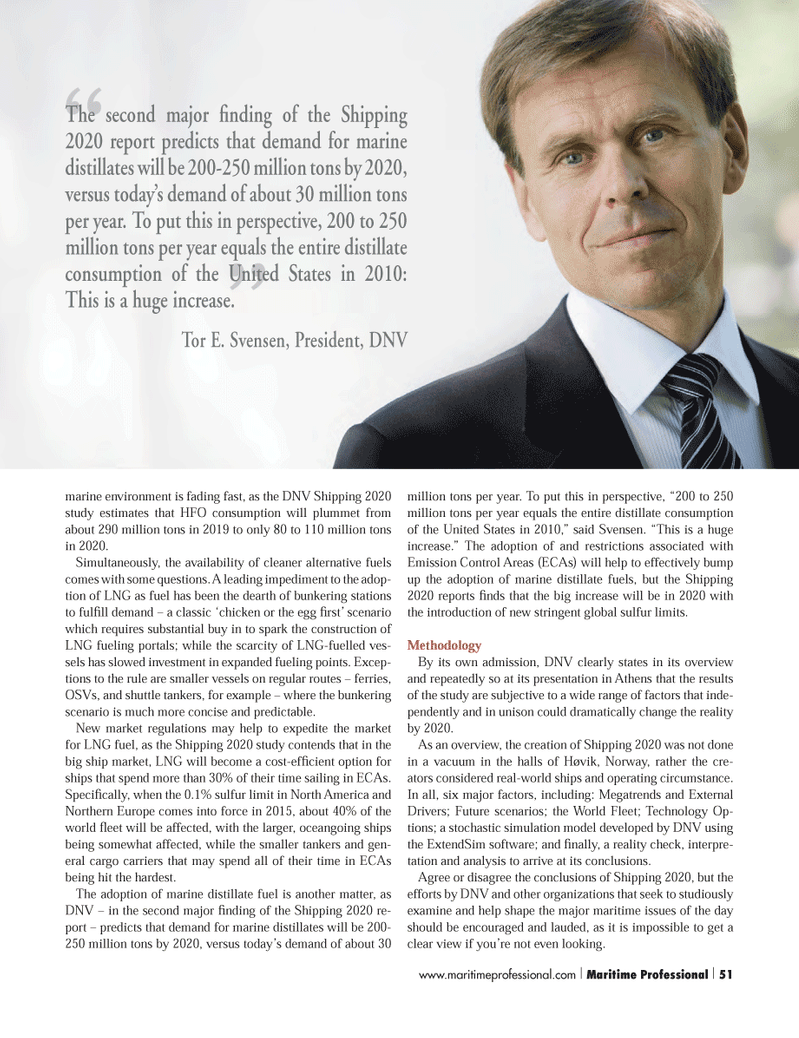
Page 51: of Maritime Logistics Professional Magazine (Q3 2012)
Classification Societies, Quality & Design
Read this page in Pdf, Flash or Html5 edition of Q3 2012 Maritime Logistics Professional Magazine
marine environment is fading fast, as the DNV Shipping 2020 study estimates that HFO consumption will plummet from about 290 million tons in 2019 to only 80 to 110 million tons in 2020. Simultaneously, the availability of cleaner alternative fuels comes with some questions. A leading impediment to the adop- tion of LNG as fuel has been the dearth of bunkering stations to fulÞ ll demand Ð a classic Ôchicken or the egg Þ rstÕ scenario which requires substantial buy in to spark the construction of LNG fueling portals; while the scarcity of LNG-fuelled ves- sels has slowed investment in expanded fueling points. Excep- tions to the rule are smaller vessels on regular routes Ð ferries, OSVs, and shuttle tankers, for example Ð where the bunkering scenario is much more concise and predictable.New market regulations may help to expedite the market for LNG fuel, as the Shipping 2020 study contends that in the big ship market, LNG will become a cost-efÞ cient option for ships that spend more than 30% of their time sailing in ECAs. SpeciÞ cally, when the 0.1% sulfur limit in North America and Northern Europe comes into force in 2015, about 40% of the world ß eet will be affected, with the larger, oceangoing ships being somewhat affected, while the smaller tankers and gen- eral cargo carriers that may spend all of their time in ECAs being hit the hardest.The adoption of marine distillate fuel is another matter, as DNV Ð in the second major Þ nding of the Shipping 2020 re- port Ð predicts that demand for marine distillates will be 200-250 million tons by 2020, versus todayÕs demand of about 30 million tons per year. To put this in perspective, Ò200 to 250 million tons per year equals the entire distillate consumption of the United States in 2010,Ó said Svensen. ÒThis is a huge increase.Ó The adoption of and restrictions associated with Emission Control Areas (ECAs) will help to effectively bump up the adoption of marine distillate fuels, but the Shipping 2020 reports Þ nds that the big increase will be in 2020 with the introduction of new stringent global sulfur limits. MethodologyBy its own admission, DNV clearly states in its overview and repeatedly so at its presentation in Athens that the results of the study are subjective to a wide range of factors that inde- pendently and in unison could dramatically change the reality by 2020.As an overview, the creation of Shipping 2020 was not done in a vacuum in the halls of H¿vik, Norway, rather the cre- ators considered real-world ships and operating circumstance. In all, six major factors, including: Megatrends and External Drivers; Future scenarios; the World Fleet; Technology Op- tions; a stochastic simulation model developed by DNV using the ExtendSim software; and Þ nally, a reality check, interpre- tation and analysis to arrive at its conclusions. Agree or disagree the conclusions of Shipping 2020, but the efforts by DNV and other organizations that seek to studiously examine and help shape the major maritime issues of the day should be encouraged and lauded, as it is impossible to get a clear view if youÕre not even looking. ??The second major Þ nding of the Shipping 2020 report predicts that demand for marine distillates will be 200-250 million tons by 2020, versus todayÕs demand of about 30 million tons per year. To put this in perspective, 200 to 250 million tons per year equals the entire distillate consumption of the United States in 2010: This is a huge increase. Tor E. Svensen, President, DNV www.maritimeprofessional.com | Maritime Professional | 51

 50
50

 52
52
